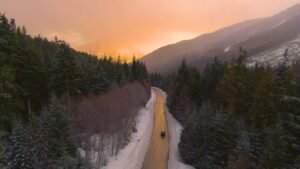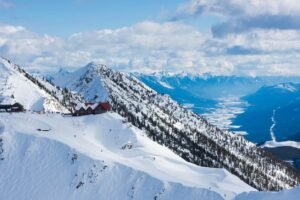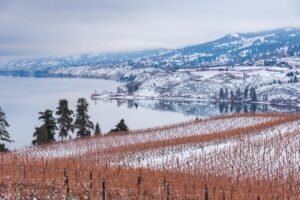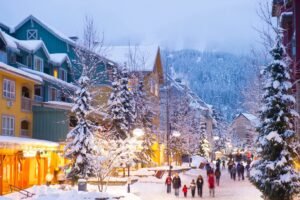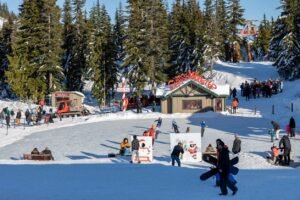Desolation Sound British Columbia, located near the Sunshine Coast and north of Vancouver, is one of the top kayaking destinations in North America. This marine park is renowned for its warm waters and dramatic mountain landscapes. You’ll discover hidden coves, rich indigenous history, and abundant wildlife. This guide provides everything you need for a successful trip, including how to get there, what to bring, and the best routes.
Key Takeaways
-
Desolation Sound Marine Park is a stunning and culturally significant kayaking destination, offering warm waters and rich indigenous heritage.
-
Careful planning for transportation, gear, and safety is crucial for a successful kayaking trip, including packing essential gear and understanding local conditions like tides and winds.
-
Various kayak rental options and guided tours are available, making it accessible for those new to kayaking or who don’t own equipment, along with opportunities for wildlife encounters and additional activities.
Discovering Desolation Sound Marine Park
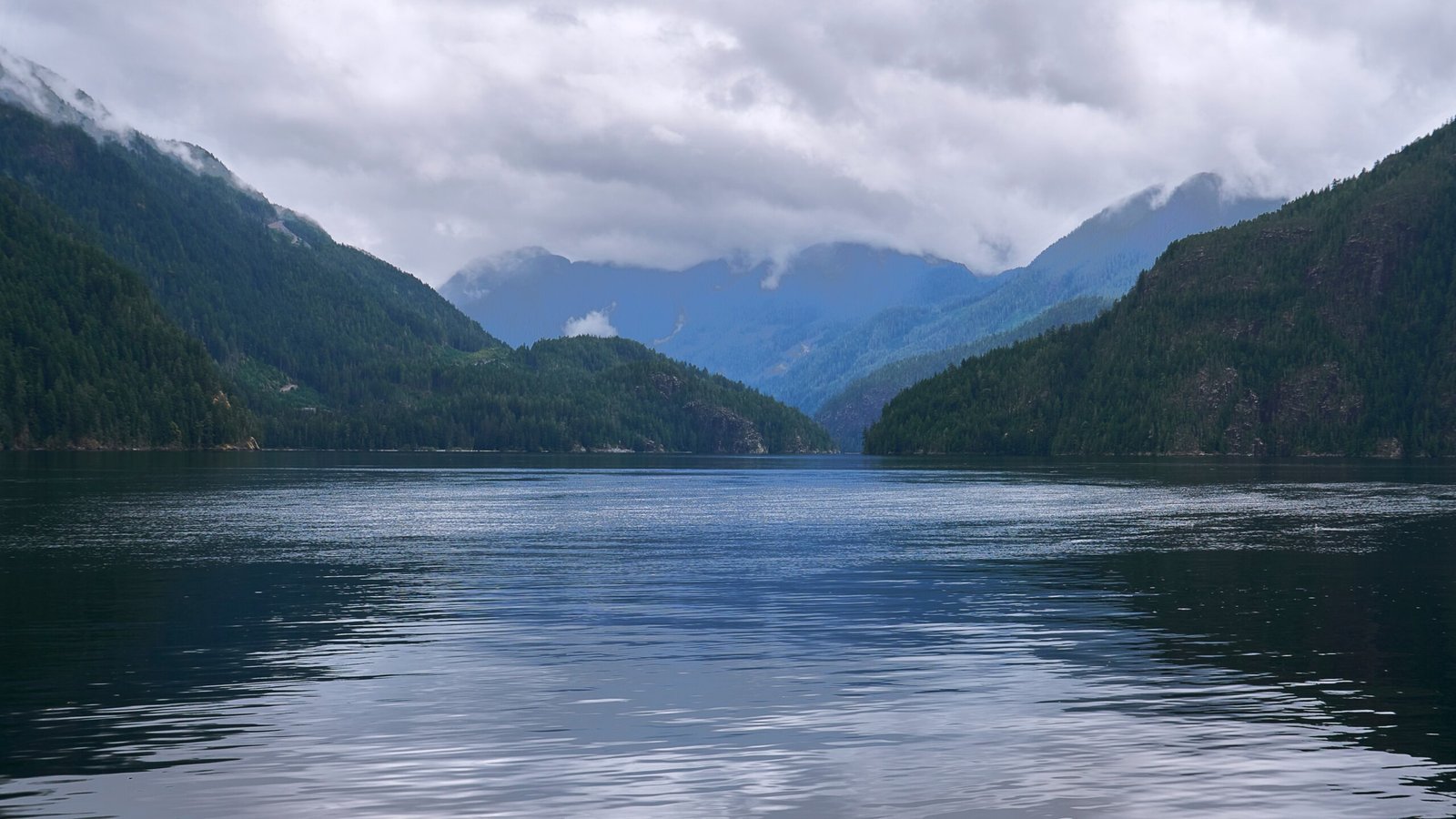
Nestled in the heart of the Salish Sea, Desolation Sound Marine Park is more than just a kayaking destination; it’s a haven of natural beauty and cultural significance. North of Powell River and Lund, approximately 145 km from Vancouver, the park spans over 14,000 acres, offering a vast playground for adventurers. Established in 1973, the park underscores its importance as a protected area.
The landscapes of Desolation Sound Marine Provincial Park are nothing short of dramatic. Picture the rugged mountain terrain of the South Coast mountain range as your backdrop, with an intricate web of river mouths and inlets weaving through the scenery. The warmest waters north of Mexico make it an ideal spot for kayaking, inviting you to explore its hidden coves, fjords, and waterfalls. The campsites in this sound marine provincial park are characterized by their wilderness settings, proximity to the ocean, and rocky shorelines, necessitating appropriate footwear.
Desolation Sound Marine Park falls within the traditional territories of the Tla’amin, Homalco, and Klahoose First Nations, adding a rich tapestry of indigenous culture and history. Guided tours often provide insights into this heritage, deepening your connection to the land and waters. Designated campgrounds and camping regulations within marine parks like Desolation Sound and Copeland Islands help protect these sensitive ecosystems while offering recreational opportunities.
How to Reach Desolation Sound
Reaching Desolation Sound is an adventure in itself, and careful planning ensures a smooth journey. From Vancouver, take two ferries: the first from Horseshoe Bay to Langdale (approximately 40 minutes), followed by a drive along the Sunshine Coast to Earls Cove for the second ferry to Saltery Bay. This scenic route offers glimpses of the stunning coastline, setting the stage for the adventure ahead.
Lund, British Columbia, is the closest community to Desolation Sound and serves as the gateway to this marine paradise. Account for ferry schedules and connections to avoid unnecessary delays.
Once in Lund, a short paddle takes you to the heart of Desolation Sound, ready for your kayaking expedition.
Kayak Rentals and Guided Tours in Desolation Sound
Desolation Sound offers options for those who don’t own a kayak or prefer a guided experience. Companies like Powell River Sea Kayak and Terracentric offer a range of rental options and guided tours, providing everything needed for a successful trip. These well-equipped packages, including sea kayaks, paddles, PFDs, and essential gear, set you up for an adventure without the hassle of bringing your own equipment.
For those launching from Lund Harbour, the kayak rental shop there provides a private launch site, making it easy to start your journey. Spirit of the West Adventures is another excellent option, offering guided tours that focus on education and wildlife, departing from Quadra Island. Powell River Sea Kayak specializes in various guided tours, including glamping-style and expedition-style adventures.
Safety is paramount; all guests renting kayaks must undergo a mandatory orientation and safety briefing to ensure proper equipment use. Experience requirements include knowledge of self-rescue techniques and understanding ocean conditions, preparing everyone for the challenges of sea kayaking.
Essential Gear for Kayaking in Desolation Sound
The right gear can make or break your kayak camping trip in Desolation Sound. Begin with a synthetic sleeping bag for its quick-drying properties. A durable dry bag keeps your gear dry; opt for small, thick, and tough versions to withstand the elements. Don’t forget a waterproof stove for cooking, as it ensures you can prepare meals even in damp conditions.
Keep emergency supplies like a first aid kit and a signaling mirror accessible for safety. Plan meals carefully, bringing extra food and selecting meals you enjoy to maintain energy levels during the trip.
Thin wool gloves are advisable for unpredictable weather to keep your hands warm without compromising dexterity.
Navigating Desolation Sound’s Waters
Understanding local conditions is crucial for navigating the waters of Desolation Sound. Wind can significantly affect your kayaking experience; check forecasts and plan trips around wind conditions. Winds under 18 km/h are generally comfortable for paddling. Wind direction impacts paddling more than current strength; always be aware of wind direction.
Tides play a vital role in navigation. Knowing the tide’s direction can save energy and time. While currents are generally mild, they can still affect your trip; consulting charts and tide tables is essential. Use a VHF marine radio to get the latest marine weather forecast every morning before setting out. Local weather conditions can differ from general forecasts; staying informed is crucial.
Use a waterproof marine chart for safe navigation, especially when visibility is low. Following these tips will help you enjoy the warm waters and serene beauty of Desolation Sound.
Top Kayaking Routes in Desolation Sound
Desolation Sound boasts a variety of kayaking routes, each promising unique experiences. For beginners, the calm waters make it a friendly destination, ideal for those new to sea kayaking. A popular two-day route starts at Okeover, leading to Feather Cove, then the Curme Islands, and back. The Curme Islands are a highlight, known for their clear, warm waters, stunning mountain vistas, and tranquil coves. West Redonda Island is another key destination, offering stunning wilderness and beautiful scenery.
Another must-visit is the Copeland Islands, just an hour’s paddle from Lund, renowned for excellent camping spots and breathtaking views.
The three major destination anchorages in Desolation Sound are Prideaux Haven, Tenedo’s Bay, and Grace Harbour, each with dramatic landscapes and serene waters. Whether planning a short trip or a longer expedition, these routes offer a mix of adventure and relaxation.
How Long Do You Need for a Kayaking Trip in Desolation Sound?
Desolation Sound Marine Park offers a variety of kayaking trip options, ranging from a day trip to a week-long excursion. The length of your trip will depend on your experience level, physical condition, and personal preferences. For a beginner, a 2-3 day trip is recommended to get a feel for the area and build confidence on the water. For more experienced kayakers, a 4-7 day trip can provide a more immersive experience, allowing you to explore the many islands, coves, and inlets of the Sound.
Getting the Skills for Kayaking
Before embarking on a kayaking trip in Desolation Sound, it’s essential to have the necessary skills and knowledge to ensure a safe and enjoyable experience. Consider taking a sea kayaking course, which will teach you the basics of paddling, navigation, and safety procedures. Additionally, practice your skills in calm waters before venturing into the Sound. If you’re new to kayaking, consider joining a guided tour with a reputable outfitter, such as Powell River Sea Kayak, to gain experience and learn from experienced guides.
The Must-Do: A Float Plan
Before heading out on your kayaking trip, it’s crucial to create a float plan, which includes your planned route, expected return time, and contact information. Leave a copy of your float plan with a friend or family member, and make sure to check in with them regularly to let them know you’re safe. This will help ensure that someone knows your whereabouts and can raise an alarm if you fail to return on time.
Weather, Tides, and Currents in Desolation Sound Marine Park
Desolation Sound Marine Park is known for its warm waters and mild currents, making it an ideal destination for kayakers. However, it’s essential to be aware of the weather, tides, and currents to ensure a safe and enjoyable trip. Check the weather forecast before heading out, and be prepared for changing conditions. Tides and currents can also affect your trip, so make sure to plan your route accordingly. The Sound’s currents are generally mild, but can be stronger in certain areas, such as the Homfray Channel.
Where to Launch Your Kayak
There are several launch points for kayaks in Desolation Sound Marine Park, including Okeover Inlet and Lund. Okeover Inlet is a popular launch point, as it provides easy access to the Sound and its many islands and coves. Lund is another option, which offers a more scenic launch point and access to the Copeland Islands. If you’re renting kayaks, your outfitter will likely provide guidance on the best launch point for your trip.
Camping in Desolation Sound Marine Park
Camping in Desolation Sound Marine Provincial Park offers a unique experience. The park features:
-
11 designated campgrounds accessible by boat
-
Each campground typically having around nine tent pads
-
Wooden tent pads and pit toilets available, ensuring a basic level of comfort
The campsites in Desolation Sound Marine Provincial Park are known for their wilderness settings, proximity to the ocean, and rugged terrain. The shorelines are rocky with limited proper beaches, so appropriate footwear is necessary.
Campfires are prohibited, so plan accordingly.
Camping fees are $5 per person per day, payable online. The camping season runs from May 15 to September 15, with some campgrounds open year-round. Bring your own water, as potable water is not available at campsites.
Camping operates on a first-come, first-served basis, and permits do not guarantee a campsite. Enjoy the pristine beauty of Desolation Sound while adhering to these guidelines.
Wildlife Encounters in Desolation Sound
Desolation Sound teems with wildlife, offering opportunities for unforgettable encounters. Harbor seals are a common sight, often basking on rocks or swimming nearby. Bald eagles soar overhead, their distinctive white heads making them easy to spot. River otters and sea lions add to the rich tapestry of marine life, while harbor porpoises surface quietly before diving again.
In the spring and fall, visitors might spot humpback whales and gray whales, often breaching and displaying their acrobatic skills. The area is home to many bird species, including ospreys and turkey vultures, often seen hunting over the water.
Responsible wildlife viewing is essential; always keep a safe distance and minimize disturbances to natural behaviors.
Additional Activities in Desolation Sound
While sea kayaking is the main attraction, Desolation Sound offers numerous additional activities. The warm waters make it ideal for swimming and scuba diving, providing a refreshing break from paddling. Freshwater swimming is available at nearby Unwin Lake, just a short walk from Tenedos Bay.
For those who prefer to stay dry, the park’s rolling hills and high cliffs offer excellent hiking. Safe anchoring spots throughout the park let visitors explore secluded coves at their leisure.
Whether you’re looking to swim, hike, or simply relax, Desolation Sound offers something for everyone.
Indigenous Heritage and Conservation Efforts
Desolation Sound is rich in indigenous heritage, part of the traditional homelands of the Tla’amin and Klahoose First Nations. The area contains multiple historical village sites where the Tla’amin people lived year-round. Today, efforts are underway to protect and educate visitors about these vulnerable archaeological sites.
A $0.5 million investment funds a two-year archaeological assessment project in Desolation Sound, involving mapping, carbon dating, and cataloging artifacts from sites over 7,800 years old. Visitor education initiatives are planned to guide people away from sensitive archaeological sites, ensuring the preservation of this rich cultural heritage.
Planning Your Trip: Itineraries and Tips
Planning your kayaking trip to Desolation Sound requires careful thought. For a comprehensive experience, plan for at least two full days and one night; weekend trips or longer expeditions offer more thorough exploration. The prime season for kayaking extends from May to early October, with July and August as peak months.
Leave a float plan detailing your route and emergency contacts before embarking on your trip. Consider tide times and wind direction for a safe journey, and have a backup plan for landing in case of fatigue or adverse weather.
Following these tips ensures a safe and memorable adventure in Desolation Sound.
What to Expect on a Guided Kayaking Tour
Choosing a guided kayaking tour in Desolation Sound offers a structured and enriching experience, much like an expedition style trip. Tours typically include necessary equipment such as kayaks, paddles, tents, dry bags, and sleeping bags. The guides are knowledgeable, patient, and flexible, fostering a fun and safe environment for all participants.
Paddling durations are around 4-6 hours each day, covering 6-8 nautical miles. Superb and wholesome food is provided to keep you energized throughout the trip.
While accommodation before or after the kayaking trip is not included, the first night often includes a stay at a resort on Quadra Island, followed by a structured daily schedule. Activities such as reviewing kayaking skills and safety procedures are incorporated into the launch, offering an educational and enjoyable experience.
Preparing for Your Adventure
Preparation is key to a successful kayaking adventure in Desolation Sound. Always leave a float plan with someone you trust, detailing your intended route and expected return. Checking the weather forecast helps in planning for safe paddling conditions and avoiding bad weather.
Ensure all your gear is packed and operational before the trip to avoid any last-minute issues. Proper preparation will help you navigate the waters safely and enjoy your time in this breathtaking marine park.
Summary
Desolation Sound Marine Park offers an unparalleled kayaking experience, with its warm waters, dramatic landscapes, and rich cultural heritage. Whether you’re navigating its waters, camping under the stars, or encountering its diverse wildlife, every moment in Desolation Sound is a memory in the making.
As you plan your trip, remember the importance of preparation, respect for the natural environment, and appreciation for the indigenous heritage that makes this area so special. So pack your gear, chart your course, and get ready for an adventure of a lifetime in Desolation Sound.
Frequently Asked Questions
What is the best time to go kayaking in Desolation Sound?
The best time to go kayaking in Desolation Sound is from May to early October, with July and August offering the warmest weather and calmest waters. If you’re looking for ideal kayaking conditions, aim for those peak summer months!
Are there guided tours available for beginners?
Absolutely, there are guided tours perfect for beginners! Companies like Powell River Sea Kayak and Spirit of the West Adventures provide everything you need, including safety briefings and equipment.
What kind of wildlife can I expect to see in Desolation Sound?
In Desolation Sound, you can expect to see harbor seals, bald eagles, sea lions, and even the occasional humpback or gray whale. It’s a beautiful spot for wildlife enthusiasts!
Do I need to bring my own water for camping in the marine park?
You definitely need to bring your own water for camping in Desolation Sound Marine Park since there’s no potable water available at the campsites. Better safe than sorry!
How do I get to Desolation Sound from Vancouver?
You can reach Desolation Sound from Vancouver by taking a ferry from Horseshoe Bay to Langdale, then another ferry from Earls Cove to Saltery Bay. From there, head to Lund, the closest community that leads you into Desolation Sound.

